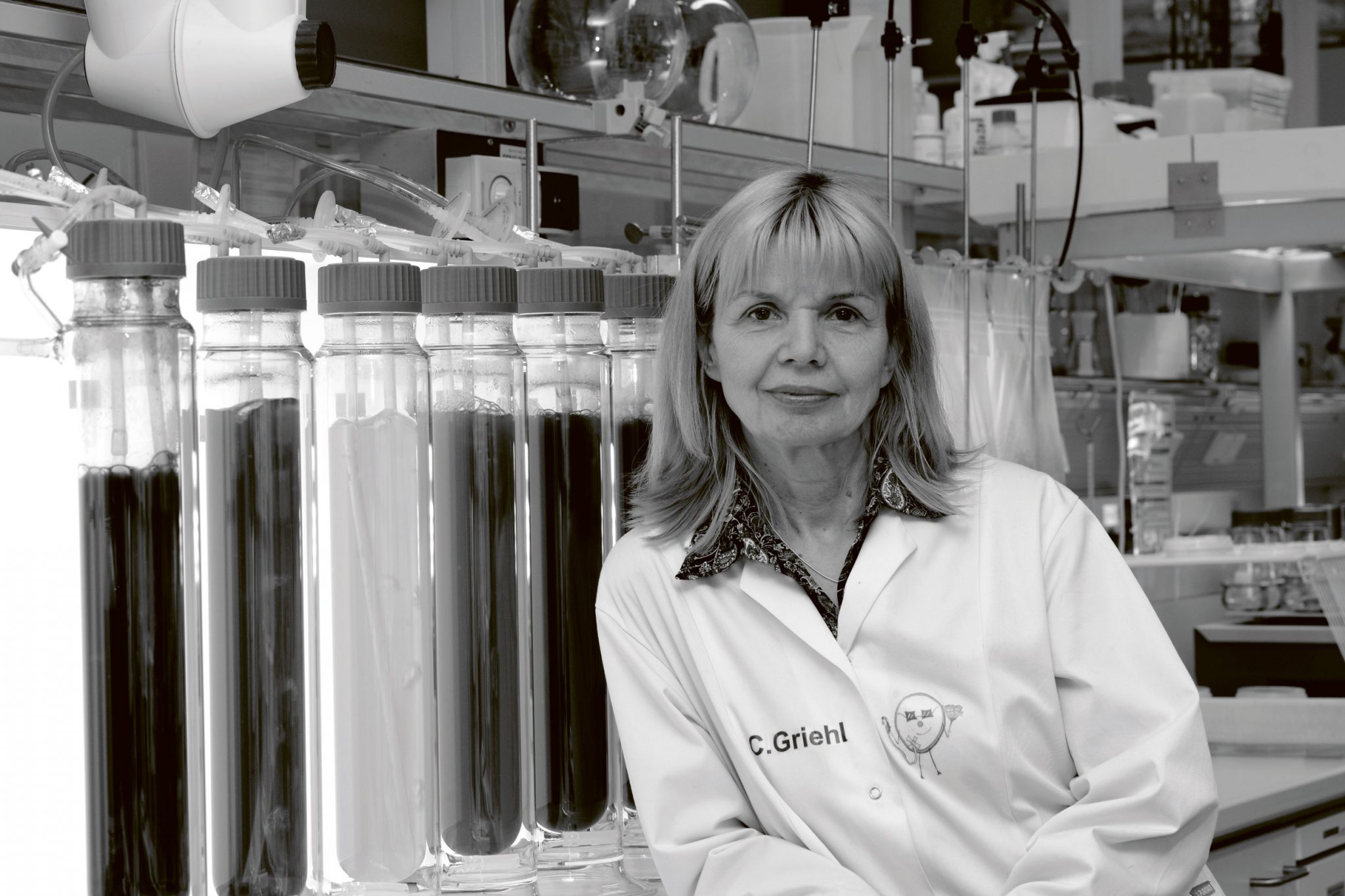INTRO MICROBES II
by Carola Griehl
Algae can be considered as aquatic plants with simple structures lacking roots, stems and leaves as well as specialized reproductive mechanisms and life cycles. They are a very diverse group of organisms that include prokaryotes (Cyanobacteria) and a large number of different eukaryote groups such as Chlorophyta, Rhodophyta, Phaeophyceae (Heterokontophyta), Euglenophyta, Bacillariophyta and Xanthophyta. Algae significantly differ in size from tiny single cells (microalgae) to giant seaweeds measuring over 60 m in length (marine macroalgae). While macroalgae are mostly marine and grow in the coastal regions of the oceans, microalgae, which can take on many different forms, also forms part of the phytoplankton communities in ponds, lakes, rivers and oceans. Although algae most commonly occur in water, some may be adapted to terrestrial conditions, thus occurring in many other ecosystems on Earth – from algae growing in the snow to those living in hot springs or in lichen associations on bare rocks and in extreme environments.
Why is there so much interest in the algae? They play a crucial ecological role in most natural habitats and, increasingly, in biotechnology. Like vascular plants algae are mostly photosynthetic organisms that utilise the energy of sunlight and carbon dioxide as a carbon source to assemble their own organic matter. As a result of photosynthetic activities over billions of years, algae have produced an enormous proportion of the oxygen present in Earth’s atmosphere, as well as organic biomass. Today, algae function as the primary producers in food webs in most habitats; for example, they are a major source of food for zooplankton, fish, as well as humans. The oxygen released during photosynthesis (from algae, or plants) is essential for the respiration and metabolism of all other organisms, including humans. During photosynthesis algae also bind nearly half of the annual amount of carbon dioxide in the atmosphere and potentially reduce global warming.
Algae are also of significant economic importance. However, only a small fraction of the estimated 500 000 different species of algae found on Earth (ca. 220 macroalgal and 15 microalgal species) are currently utilised commercially; for example, they have numerous applications as foodstuffs, animal feed, or cosmetic ingredients. Worldwide, 16 million tonnes of macroalgae and 75 000 tonnes of microalgae are produced annually, mainly in China, Korea and Japan.
The majority of the brown and red macroalgae, which are often rich in vitamins, iodine, calcium (and other minerals) and polysaccharides, have long been used as vegetables in different parts of the world (e.g., as Wakame, Nori, Kombu, Aonori or Dulse). Many products are also derived from red and brown algae, including alginates, agars and carrageenans, that are employed as gelling and thickening agents for the production of cosmetics, foods (jam, ice cream, pudding), pharmaceuticals, paints, toothpastes, paper sizing and bandages.
Currently the largest market for microalgae appears to be in the area of food supplements and feedstuffs. Over recent years there has been a growing microalgal-based biotechnology industry, producing antioxidants, natural pigments (e.g., β-carotene, astaxanthin, phycocyanin) and cholesterol-lowering, polyunsaturated fatty acids (docosahexaenoic acid).
A significant potential of algae is considered to be the discovery of multiple, unknown biologically active secondary metabolites, which could be used as potential active ingredients against currently non-curable diseases (such as Alzheimer’s, cancer, neurodermatitis, rheumatism, AIDS).
Microalgae have also become the focus of research in the development of renewable biofuels that are not in competition with food production and simultaneously utilize climate-damaging carbon dioxide at the site of its formation. The EADS Group launched the first algae spirit aircraft in 2010, whose fuel had a higher energy content than conventional fuels. However, the fuels derived from algae can currently not compete with kerosene financially. To this end, a number of research and development activities are needed that focus on a cost reduction in cultivation, harvesting and processing; these should also include the co-production with high-priced materials and energetic use of residual algae biomass.
In the project microbes II – a day made of algae coordinated by Prof. Mareike Gast, students of Industrial Design at the University of Art and Design Halle spent a semester considering all aspects of algae. Adopting an interdisciplinary and artistic point of view, they explored how this valuable, almost untapped raw material could be made usable and whether existing materials and products could be replaced by algae. Is there also a possibility to create new applications, properties, characteristics and usage scenarios? To this end, the students dived into algal research in Köthen in the laboratories of the Anhalt University of Applied Sciences and developed innovative future-oriented concepts.
Creating a novel interface between biotechnology and design, emerging attractive opportunities demonstrated how effective interdisciplinary collaboration between two disciplines opened exciting new perspectives on scientific topics. Addressing many different questions, ranging from “How can nuisance algal blooms be turned into something beneficial?” to “Can the growth of algae be aligned with defined three-dimensional geometries?”, this book documents the scientifically supported contributions and visualizations of Industrial Design students regarding algae and its opportunities of application.

Dr. Carola Griehl is a professor of biochemistry at Anhalt University of Applied Sciences in Köthen and focuses on Algal Biotechnology. She is the head of Competence Center Algal Biotechnology and founded the Biosolar Center of Anhalt University.
We collaborated closely with Carola Griehl during the project microbes II.
